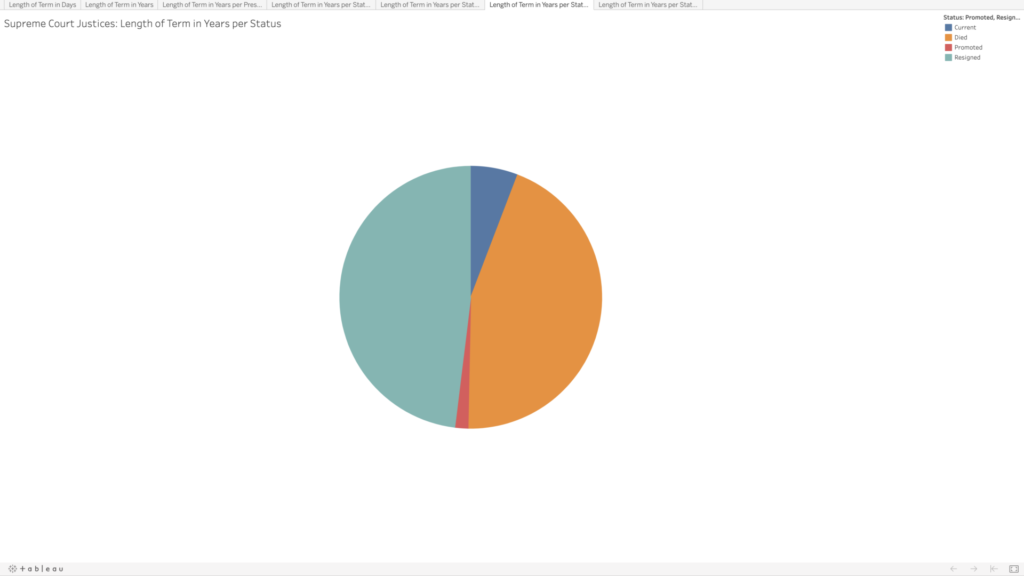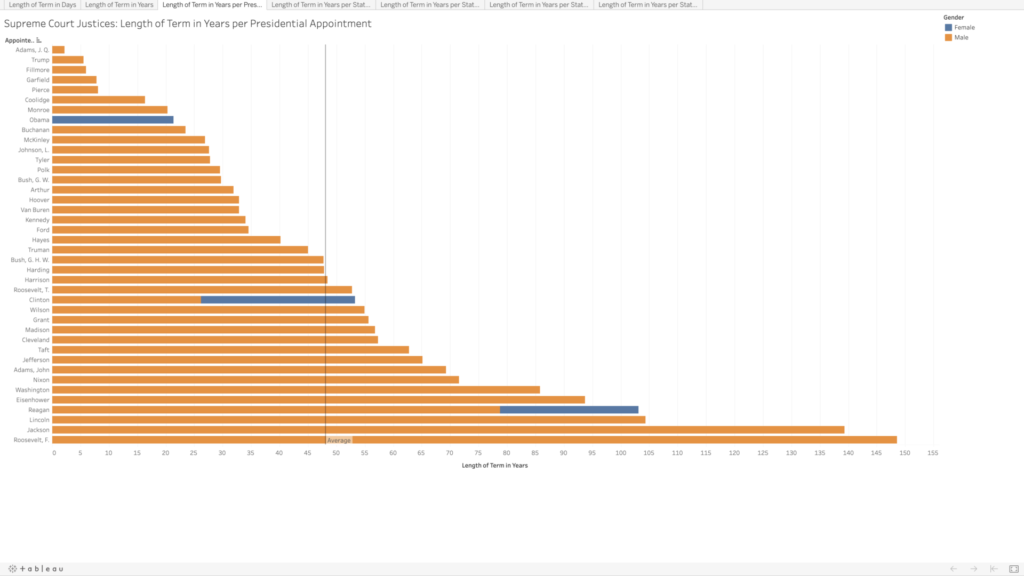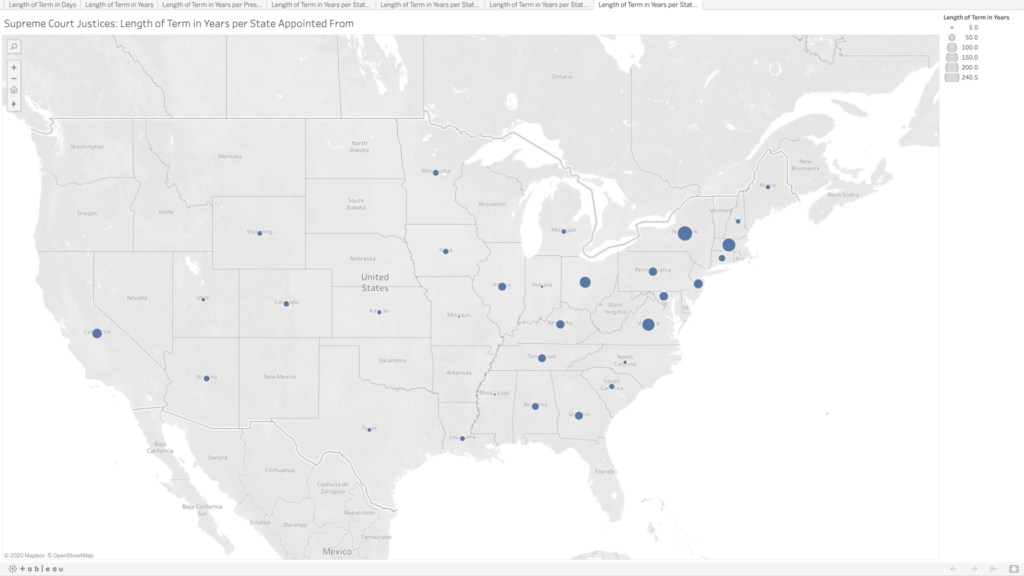Given the recent death of Ruth Bader Ginsburg and the current Senate hearings for her nominated replacement, Amy Coney Barrett, the Supreme Court is all over the news. Supreme Court justices are not elected, and once approved by the Senate, they receive lifetime appointments. I wanted to know what those lifetime appointments translate to in actual term lengths.
Collecting and Sorting the Data
The majority of the data I wanted were conveniently available on the Supreme Court website, where they list every justice since the court began in 1789 to the present, including their title (chief justice or associate justice), the date they took their oath, and the date their service ended, as well as what state they were appointed from and which president appointed them. They list some caveats on their site regarding the dates, but for my purposes I chose to ignore them and just accept the dates given.
I copied their data into an Excel file, and integrated the chief and associate justices together, sorting in chronological order by oath date. In doing so, I realized there are three justices who held both titles, John Rutledge was the first, with a break in between titles (total of both terms is approximately 1.40 years). Harlan Fiske Stone and William H. Rehnquist also held both titles, being promoted from associate directly to chief justice (Stone’s total term length is 21.14 years, and Rehnquist’s is 33.66 years). In my tables, each of these three people have two listings by their names because of this, so it does slightly skew my average term length of 16.16 years (more than twice as long as the current term limits on presidents).
The Supreme Court was created in 1789, initially with one chief justice and five associate justices. It was expanded in 1869 to consist of one chief justice and eight associate justices (the number we have today). I wanted to calculate the length of each justice’s term in both days (because it would be whole numbers) and years (as these would be more recognizable and understandable), which was tricky in Excel as it does not recognize dates before January 1, 1900. For all of the justices who had both oath and termination dates after 1900, I was able to use existing formulas to calculate these values. For the dates preceding this, I copied them into a new sheet, and I added 1000 to each year to get Excel to recognize the values as dates, and then I was able to use the same formulas as before, though I had to copy the unformatted numbers into Word before pasting back into my main Excel table to make sure it kept the values rather than the formulas. For the current justices, I put in “termination” dates of today, October 13, just to get some sense of their term lengths thus far, though again I realize this is skewing my average and trends.
In addition to the term length, I also wanted to note the gender of each of the justices (which admittedly is problematic as I am assuming a gender binary and also ascribing gender to these people based on their name and pictures). Of the 119 appointed justices, only 4 have been women.
Given that justices have lifetime tenure, I also wanted to see how the terms were ending. Going into this, I had assumed that most justices’ terms ended with their deaths; however, it turns out there is a pretty even mix between resignation and death. This information wasn’t included on the Supreme Court website, so I searched each justice’s Wikipedia page to compare the date their term ended with their death date. Some entries made a distinction between resignation and retirement, but for my purposes I selected “resignation” for any justice whose term ended before they died. Back to Rutledge, he resigned twice; Stone and Rehnquist were both promoted directly from associate to chief. There are eight justices whose terms are ongoing—who I noted as “current.”

Visualizing the Data
I decided to use Tableau again to get more familiar with its features and tools. I played around with the data a bit to see if I could spot any trends in the term lengths—e.g., did term lengths get longer as life expectancy increased? To my untrained eye, the term lengths don’t seem to follow much of a trend. When looking at resignations versus deaths, there do appear to be some groupings—though I’m not sure what, if anything, could be inferred by this.

In playing around, I was able to visualize which presidents had the most sway in the Supreme Court, in terms of the total term lengths for all of the justices they appointed. I assumed Washington would be the clear leader, having the benefit of being the president to appoint the most justices, but several others beat him out, and Franklin D. Roosevelt has almost double the total terms (85.8 vs. 148.6 years). There are only four presidents who did not appoint any Supreme Court justices (William Henry Harrison, Zachary Taylor, Andrew Johnson, and Jimmy Carter).

Lastly, because why not, I wanted to see the term lengths as they related to the states where the justices were appointed from. There are many states that have never had any Supreme Court justices, especially as you move further west. Again, I’m not sure what arguments about representation could be made here; I would think this speaks more to “manifest destiny” and the way in which states were created and admitted to the union than anything else.

Ideas for Future Expansion
Initially I had been curious to compare all of the justices by the age at which they began their terms, but that would have been a bit too time-consuming. I’m still curious to see if there are any trends here. All Article III federal judges are appointed for lifetime tenure (technically they can be removed, but in practice it seems like appointments are more or less until death or resignation), so it would be great to get data for all of them as well and see what kind of trends pop up.





Brianna, your project is awesome! As a history nerd, I really like how you decided to take a quantitative approach to the Supreme Court. And what a timing!
I wish I had this when I was studying for my American History exam during my MA in Italy…it would have given me a different perspective 🙂
This is very educational and eye-opening. The fact that these positions are “for life” and we currently have an opening about to be filled makes this even more important. Thanks for the enlightenment! Also — Excel does not recognize dates before January 1, 1900 — how is this even possible?!?!?
Right? This has been a problem with Excel for years–why won’t they fix it?